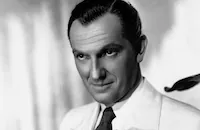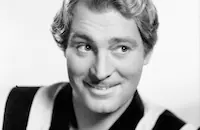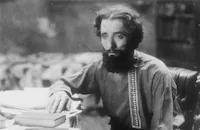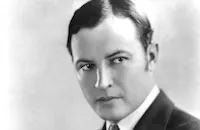The Garden of Allah

Brief Synopsis
Cast & Crew
Richard Boleslawski
Marlene Dietrich
Charles Boyer
Basil Rathbone
C. Aubrey Smith
Joseph Schildkraut
Film Details
Technical Specs

Synopsis
After the death of her invalid father, wealthy Domini Enfilden returns to Le Couvent de Ste. Cecile, where she was reared, to seek counsel from Mother Josephine about her loneliness. The Mother Superior tells her that in the solitude of the Sahara Desert, she might find herself. Meanwhile, at a Trappist monastery at el Lagarnine in Tunis in Northern Africa, a visitor, Captain de Trevignac, tastes the liqueur for which the monastery is famous. The liqueur is made from a secret formula by Brother Antoine, who has just fled the monastery, taking the secret with him. En route to the city of Beni Mora, Algeria, Domini meets Antoine on a train, but he is silent. Later, in a cafe, Antoine is entranced by an exotic dancer named Irena. When Irena pulls a knife on her lover, Hadj, who will not marry her, Antoine helps Domini flee, and introduces himself as Boris Androvsky. The next day, they ride to the Oasis of the city Azur, where they meet Count Ferdinand Anteoni, who tells Domini to wait to venture into the desert until the urge is very strong. When native girls admire the crucifix around Boris' neck, he gives it to them by casting it in the water. Although Boris attracts Domini, he shocks her by his violent antipathy to religion. Anteoni warns Domini, "a man who fears to acknowledge his God is unwise to set foot in the desert," and tells them that the Arabs have a saying that the desert is the garden of Allah. Later, a sand diviner tells Domini that something glorious is in store for her during her pilgrimage into the desert, but also gives her a grave warning. As the weeks pass, Domini and Boris fall in love, and Boris still keeps his past a secret. While out riding, they come to a church, as the seer foretold. There, Father J. Roubier, who promised Mother Superior he would look out for Domini, notices Boris' fear and anger toward the church. Although the priest warns Domini not to make friends with Boris, after Boris threatens to leave, he and Domini swear their love, and the priest agrees to marry them the next day. Following the wedding, Boris and Domini take a caravan into the desert with Domini's guide, Batouch, and Hadj. One night, Domini lights a torch to guide Boris back to the camp, and inadvertently saves a patrol that has been lost for three days. Among the men is de Trevignac. Boris returns and de Trevignac is sure they have met before. After Batouch serves a bottle of the Lagarnine liqueur, de Trevignac remembers who Boris is and leaves the table in anger. Domini, confused, pleads with Boris to tell her the truth, but he refuses. At dawn, Domini asks de Trevignac to tell her what happened between him and Boris, but he merely crosses himself and walks away. De Trevignac and his men depart, but he tells Anteoni where the caravan is camped. At dinner, Anteoni tells the story of the Lagarnine liqueur, which will never again be manufactured as the monk who knew the secret of the liqueur disappeared after taking his final vows. Domini is horrified by the story, but Boris asserts that the man had a right to love, then cries at the realization of what he has done. After Anteoni leaves, Boris falls on his knees in the sand and tells Domini about his life at the monastery, where he had lived since childhood under the vow of silence, and spoke with people for the first time when, as an adult he was put in charge of the monastery's hotel. Believing that no one who loves will be punished by God, Domini agrees to let Boris return to the monastery and make reparations, promising that they will be together forever. At the gates of the monastery, Boris and Domini embrace for the last time.

Director

Richard Boleslawski
Cast

Marlene Dietrich

Charles Boyer

Basil Rathbone

C. Aubrey Smith

Joseph Schildkraut

John Carradine

Alan Marshal

Lucile Watson

Henry Brandon

Tilly Losch
Helen Jerome Eddy
Marcia Mae Jones

Ann Gillis
Charles Waldron
John Bryan

Nigel De Brulier
Pedro De Cordoba
Ferdinand Gottschalk
Adrian Rosley

Robert Frazer
David Scott
Barry Donning

Bonita Granville
Betty Jane Graham
Andrew Mckenna
Betty Van Auken
Marion Sayers
Edna Mae Harris
Frances Turnham

Leonid Kinsky
Louis Aldez
Jane Kerr
Russell Powell
Eric Alden
Michael Mark
Harlan Briggs
Irene Franklin
Louis Mercier
Marcel De La Brosse

Robert Stevenson
Corky

Frank Puglia
Ann Bupp
Crew
Bill Bowman
Edward Boyle
Tom Carmen
Sturges Carne
Bob Carney
Wilfrid M. Cline
Nelson Cordes
Jack Cosgrove
Jeannette Couget
Don Dickey
Ernst Dryden
Willis Goldbeck
Willis Goldbeck
W. Howard Greene
Lansing C. Holden
Natalie Kalmus
Sam Kaufman
Hal C. Kern
Frank Leavitt
W. P. Lipscomb
Oran Mcpherson
Virgil Miller
Chauncey Pyle
Lynn Riggs
Morris Rosen
Harold Rosson
David O. Selznick
Irving Sindler
Eric Stacey
Max Steiner
Anson Stevenson
Lyle Wheeler
Earl A. Wolcott

Videos
Movie Clip



Film Details
Technical Specs

Award Nominations
Best Director
Best Score
Articles
The Garden of Allah
The Garden of Allah was based on a popular novel by Robert Hichens and had already been filmed twice before as a silent picture in 1916 and 1927. While still at MGM, Selznick envisioned Greta Garbo in the role of Domini, a devout woman who unknowingly falls in love with a Trappist monk who has fled his order in a crisis of faith. When Selznick left MGM and founded his own production company, Selznick International Pictures, he bought the rights to the story for $62,000. By then he had hired actress Merle Oberon to play Domini, but he ended up paying her $25,000 to cancel her contract since he didn't feel she had enough box-office draw. Selznick replaced her with Marlene Dietrich, on loan from Paramount, who still had box-office appeal despite a string of recent disappointments. Selznick paid her $200,000 and hired debonair French actor Charles Boyer to play the tortured monk, Boris Androvsky.
Selznick remained at his office in Culver City, California, while he sent the cast and crew to a remote part of the Arizona desert known as Buttercup Valley to begin shooting. He was well aware of Dietrich's reputation as a diva, and tried to put director Boleslawski's mind at ease about working with her. He assured him that he had talked to Dietrich about how high the picture's budget was and how "it was up to her to keep it from going higher." Selznick also cautioned Dietrich about her behavior, and she promised pure professionalism. In a memo to Boleslawski dated April 14, 1936, Selznick advised him to "go right ahead as though you were directing some newcomer, and not worry about any legend of Dietrich difficulties."
In another memo to Boleslawski just two weeks later, Selznick's tone was markedly different: "I am getting to the end of the rope of patience with criticism based on assumption that actors know more about scripts than I do." He had heard reports that Dietrich was arguing over camera angles, costumes, makeup and hair. The other actors were also "ganging up" to have things done their way, egged on by Dietrich's insolence. Selznick insisted that Boleslawski talk to Dietrich and Boyer privately and let them know that "neither of them has ever had a single picture comparable with any one of fifteen that I have made in the last years." If the actors didn't shape up, he threatened to let their "sloppy" performances remain without appeasement and release the film as it was.
One of the co-stars of The Garden of Allah, Basil Rathbone, had worked on three previous Selznick productions, but he picked the wrong time to ruffle the harried producer's feathers. In his 1956 autobiography In and Out of Character, Rathbone recalled how one day on the set of Allah he refused to rehearse a scene because it cast his character, Count Anteoni, in an unsympathetic light. Selznick was incensed and ordered him to do as he was told or "he would press charges of insubordination" against him with the Screen Actors Guild. "You will never work for me again as long as you live!" Rathbone recalls Selznick snapping at him that day. He never did.
As the film went over budget, something unusual for a Selznick production, another small battle broke out over Marlene Dietrich's hair. With most of the film's action taking place outside in the desert, Selznick noticed while watching the dailies that winds would be blowing the trees, but Dietrich's hair never moved an inch. "Would you please speak to Marlene about the fact that her hair is getting so much attention, and is being coiffed to such a degree that all reality is lost," he exasperatedly pleaded with Boleslawski. "Her hair is so well placed that at times it remains perfectly smooth and unruffled; in fact is so well placed that it could be nothing but a wig. Surely a little reality can't do a great beauty any harm." Dietrich's daughter Maria Riva recounts in her 1993 biography of her mother, Marlene Dietrich, that Marlene was angry making the film, and "she compensated by overemphasizing the one category she could control -- the way she looked."
"I came to hate working on that movie," Marlene Dietrich said of The Garden of Allah in her 1987 autobiography Marlene. "My curls, the bombastic script -- everything annoyed me." Still, she surprisingly praised Selznick and said that she actually liked working for him because he took charge, was clear about what he wanted, and was generous with production money. "Selznick was the greatest perfectionist I have ever known," she continued and called The Garden of Allah "the most beautiful color film ever made."
With the cast falling ill, expenses stretching far beyond budget, star temperaments running hot, and constant problems with the new Technicolor process, Selznick eventually called the cast and crew back to California where filming was completed on a studio soundstage. Released in November of 1936, The Garden of Allah did not do as well as Selznick hoped, though it won a special Academy Award for its use of color cinematography.
With its stunning and much praised visual beauty, The Garden of Allah has found new appreciation over the years. Watching the film's tranquil elegance, it's hard to imagine the behind-the-scenes drama that plagued the production, but the desert melodrama is all the more interesting to watch because of it.
Producer: David O. Selznick
Director: Richard Boleslawski
Screenplay: W.P. Lipscomb, Lynn Riggs
Art Direction: Edward Boyle, Sturges Carne, Lyle Wheeler
Cinematography: W. Howard Greene, Harold Hal Rosson
Editing: Hal Kern, Anson Stevenson
Music: Max Steiner
Cast: Marlene Dietrich (Domini Enfilden), Charles Boyer (Boris Androvsky), Basil Rathbone (Count Anteoni), C. Aubrey Smith (Father Roubier), Tilly Losch (Irena), Joseph Schildkraut (Batouch), John Carradine (Sand Diviner), Alan Marshal (De Trevignac), Lucile Watson (Mother Superior).
C-79m.
by Andrea Passafiume

The Garden of Allah
Quotes
What an extraordinary man. Is he mad?- Domini Enfilden
Yes, he's undoubtedly English.- Batouch
There are things in a man's life it's best to forget. There are dark places which should be left dark.- Boris Androvsky
Take care! You've come to a land of fire. And I think you are made of fire.- Father Roubier
A man who refuses to acknowledge his god is unwise to set foot in the desert.- Count Anteoni
Trivia
Merle Oberon was originally signed to play Domini, but was "bought off" by David O. Selznick at a cost of $25,000.
All of the "Arabic" spoken in the film is gibberish.
Notes
A July 1936 Hollywood Reporter news item notes that United Artists postponed this film's release to late October in order to give David O. Selznick time to "match up" all Technicolor prints. Numerous sources credit both Anson Stevenson and Hal Kern as the film's editors, although only Kern is listed on the film. Two contemporary sources credit Edward Boyle with settings in addition to Sturges Carne and Lyle Wheeler, while one source lists Wheeler and Boyle as Carne's associates. Motion Picture Herald reports that Lynn Riggs was engaged for additional dialogue, although she receives screenplay credit on the film. The film was shot in a desert camp twenty-three miles outside Yuma, AZ, the same site that Twentieth Century-Fox used for Under Two Flags (see below). According to a contemporary source, the film staff and company was so large, it used short-wave radios to communicate between the film unit and the studio. As reported in Time, this film took six months to make and cost more than two million dollars. The Garden of Allah was the last film completed by director Richard Boleslawski, who died of a heart attack on January 17, 1937 while working on The Last of Mrs. Cheyney, an M-G-M film.
According to files in the MPAA/PCA Collection at the AMPAS Library, Selznick wanted to cast Greta Garbo in the lead for this film, but was unable to finish the script within the time limitation of her contract. On February 7, 1935, Selznick wrote to Joseph I. Breen, Director of the Studio Relations Office of the AMPP, conveying his apprehension concerning the possible public reaction to the film's story. Selznick asked if a monk is allowed to return to the church under the tenets of Catholic doctrine and if Hichens' novel had been banned by the church. Selznick hoped Breen would respond quickly, as he hoped to cast Joan Crawford in the role and had "little time" in which to do so. Breen responded on 9 February that he believed the story presented no difficulty as Hichens wrote it. He also reported that he had sent queries to three leading Catholic churchmen for criticism. Reverend Edward S. Schwegler, Chairman of the Board for the Legion of Decency in the Diocese of Buffalo, warned Breen that the "theme of fallen monk will be offensive to Catholics," while another was "entirely against proposed adaptation"; a third asked whether the monk could become a priest only at the end of the film. Schwegler wrote to Breen again on 11 Feb, after reading Hichens' novel, stating the following: "The idea of a priest, a monk, having intimate carnal relations with a woman just grates against the grain....You and I know that such sort of relationships have existed and do exist; we know that in the past priests have married and had concubines almost with impunity;...but all that does not alter the fact that here, to the ordinary, simple Catholic, the thought of a priest having carnal relations with a woman is sacrilegious." Schwegler also objected to the "barbarically sensual" dance scene [featuring Irena] in the book. On 18 Feb, Breen reported to Selznick that, according to four clergymen, a fallen monk would be accepted back into the church, probably with penance; that to their knowledge, the book had not been banned; and that the story was acceptable, but was likely to give offense to the Catholic laity. By April 30, 1936, Dietrich had been cast in the film. Throughout shooting, Selznick was in touch with Breen. On 9 Jun, Breen wrote to Selznick "in confidence, informally," that a priest had objected to the speech "in which Boris thanks God for having loved Domini-as if he is thanking God for sin." Breen asked Selznick to change the speech only if it did not detract from the story, in order to "free me of [the priest's] wrath." The speech, as it appeared in the viewed print, read: "I was born perhaps to serve God. I dare to believe that I was born to know your beauty, your tenderness....I have begged God in His mercy to forgive me for having loved you. For in knowing your love, I have known him." On April 15, 1937, the film was banned in Italy "on moral and spiritual grounds"..."the whole description of the film is objectionable." On May 4, 1937, Frederick L. Herron, Treasurer of the MPPDA, wrote to Arthur W. Kelly, a United Artists executive, regarding the banning of The Garden of Allah by the Vatican. Mario Luporini, of the Artisti Associati in Rome, wrote to George Archibald, joint managing director of UA's London office, that the Vatican authorities consider American Catholics and other Catholics outside of Italy as "too broadminded!" According to a letter dated August 31, 1937 from Fred M. E. Mueller, in charge of United Artists' Italian branch, to UA executive Harold Smith, the film had been entirely rewritten, abolishing all monastery scenes and all references to Boris' monastic life, but, currently, censors were rejecting it for "artistic reasons."
Although contemporary sources reported in late March 1936 that Merle Oberon had turned down the lead in this film in favor of the lead in Dark Victory [which eventually was made by Warner Bros. starring Bette Davis], on 15 Apr, it was announced that she had filed suit the previous day against Selznick International for $125,333 for breach of contract. Oberon claimed that Selznick had offered her the lead in a film based on the life of Florence Nightingale, but when the project was cancelled, The Garden of Allah was proposed, for which Oberon was to receive the same salary offered to her for the Nightingale story. Oberon alleged that she reported for duty on the Allah production, but was not assigned the leading role. Because of the continued unavailability of Dietrich as a witness and Oberon herself, the trial was again set for March 11, 1940, at which point Oberon dismissed the case.
Max Steiner was nominated for a 1936 Academy Award for Best Score and Eric Stacey was nominated for Assistant Director. According to a news item in the New York Times, the film was not nominated for Best Picture because it was believed its natural effects would "outpoint the conventional product." Members of the Academy, therefore, granted W. Harold Greene and Harold Rosson a special award for color cinematography. On November 30, 1936, a Time cover story called this film the "best example of color photography the cinema has so far contrived." Daily Variety reported that under the designing in tint by Lansing C. Holden and supervision by Natalie Kalmus, Techicolor had gone "into refinements and effects heretofore never achieved." In interview quoted in a modern source, cinematographer James Wong Howe says that he had done tests for Dietrich for this film and would have shot it had he not been committed to another film. Howe also says that Dietrich had a full-length mirror alongside her at all times while filming to judge the light, and would tell Howe what she wanted accordingly.
According to a news item in the New York Times, this film's sets were burned as part of the burning of Atlanta in Gone with the Wind. The New York Times also reported that when Dietrich went on vacation after filming The Garden of Allah, her double, whose last name according to the New York Times was also Dietrich but whose first name has not been determined, was used in retakes of long shots. According to a contemporary source, Dietrich and Carole Lombard fought over the use of still photographer Don English of Paramount. Dietrich wanted him for The Garden of Allah, and Lombard for My Man Godfrey at Universal. A $100,000 exploitation campaign launched for the film featured an international one-hundred-word essay contest that offered a free trip to Egypt, and a transcontinental advance tour of a honeymoon tent truck. UA also sponsored a contest among theater owners, offering a 39-day trip to the Mediterranean for the best exploitation campaign. On March 12, 1937, Hollywood Reporter states that Mildred Ray Stancliff of Los Angeles, the winner, out of 1,500 contestants, of the essay contest, left on March 10, 1937 for the last leg of her trip to North Africa. According to his autobiography, Joshua Logan worked as dialogue director on this film, although a news item in Hollywood Reporter on April 13, 1936 states that Logan, a Broadway stage director at the time, was being groomed by Selznick as a screen director and was assigned as an observer on the Garden of Allah set.
This film marked Tilly Losch's screen debut. The New York Times refers to Losch's character as "Ouled-Naïl girl," an Arab prostitute and dancing girl of North African cities. Several reviews mention Losch's alluring dance sequence, and Motion Picture Herald states it is "so outside the bounds of decency and Code Regulations that sharp cutting is in order." Daily Variety said, "Tilly Losch provides the most colorful and arresting scene in the picture when she dances the abandoned temptation to Boyer in the desert inn. The dance is the most erotic and at the same time fascinatingly artistic thing of this kind the screen has seen, and the emotional quality of the intimate play between the nautch terper and the runaway monk is of intense pitch." Alberta censor boards required the shortening of Losch's "voluptuous muscle dance," while Ohio censors insisted on the elimination of all of Losch's "sinking down and coming up and moving her stomach." For the 1927 M-G-M version of The Garden of Allah, local censor boards also objected to the women dancing seductively before men, particularly the shots of them moving their abdomens. The 1927 film was directed by Rex Ingram and starred Alice Terry and Ivan Petrovich (see AFI Catalog of Feature Films, 1921-30; F2.2015). According to Hollywood Reporter, Ingram and Terry stood across the street from Graumann's Chinese Theatre as crowds left the 1936 film's preview. Selig Polyscope also produced a version in 1916, directed by Colin Campbell and starring Helen Ware and Thomas Santschi (see AFI Catalog of Feature Films, 1911-20; F1.1520). Selznick's version was re-issued in 1945.

Miscellaneous Notes
Released in United States 1936
Released in United States 1936













